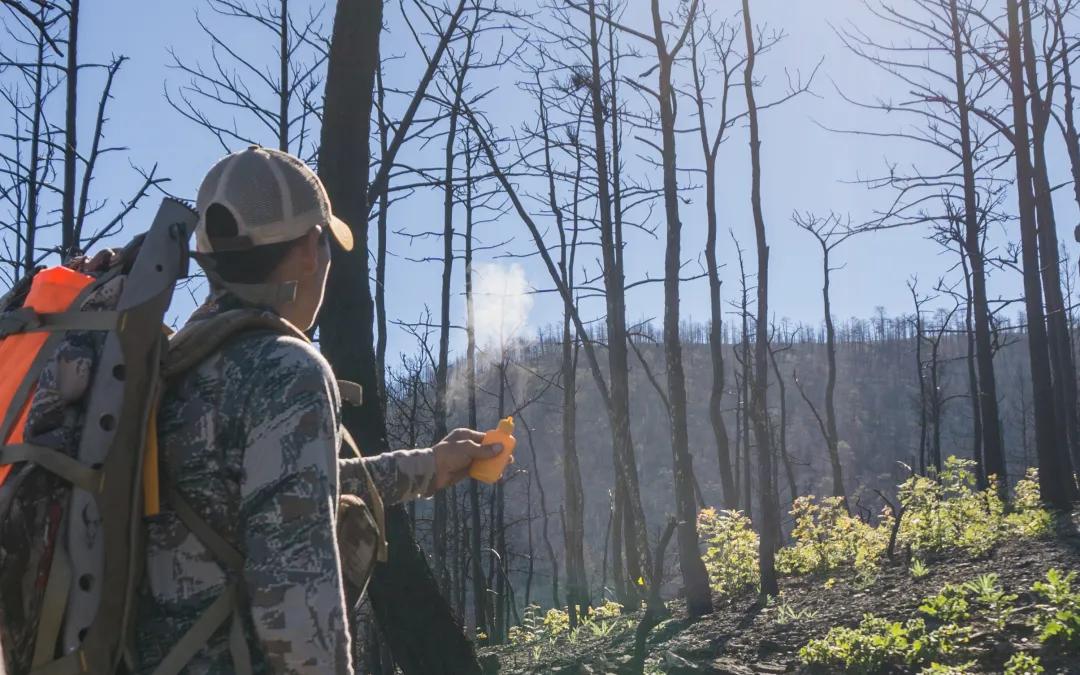Blog
Play the Wind – How Thermals Influence the Stalk

If there’s one thing that can kill the mood on any hunt, it’s scent. When an elk or deer catches your smell, it’s often game over and they are gone. Playing the wind is obvious but the thermals are often more nuanced and should be used to guide each stalk.
The entirety of thermals revolves around heat exchange and the way hot and cold air will rise and fall, carrying your scent while traveling.
Warm Air Rises
The warmer air is less dense than cool air and it rises, creating a current also called a thermal stream. The more extreme and abrupt the temperature change, the faster and more intense the current. As it pertains to hunting, the morning sun warms the air on the ground, causing it to rise upwards.
If you hunt mornings, keep a close eye on the sun, as it can suddenly change the thermals. Before sunrise, thermals will usually be moving downhill. But as soon as the sun hits the ground, thermals can begin moving uphill with the rising warm air. Use these movements to your advantage. Hunt your way uphill early in the mornings with the wind in your face – but beware of that sudden change as the sun appears. You can sidehill as well, so long as that thermal advantage is maintained.
Cold Air Falls
The opposite scenario occurs as the air cools and drops downwards. In the evening, when the sun drops away and shadows begin the cooling phase, the cool air may begin dropping with your scent. If you’re above the animals, it will carry directly to them. As afternoon becomes evening, hunters should adjust their position below the game so that cool air carries their scent away.

It’s Not Always So Simple
The concept of thermals is often predictable but breaks and terrain changes influence the way air moves. Thermals can rise on the sunny side of a ridge and simultaneously fall on the shaded side, creating opposing drafts. It can also swirl and change course based on rock formations, trees and features in the landscape.
One of the best ways to get a feel for the thermals is to pre-scout and walk the area well ahead of hunting season. While the temperature and weather will change, the general sun directions and landscape will remain predictable and you will have a better grasp on where to walk and stalk.
Beware the Swirls and Prevailing Winds
Thermals offer an advantage when properly utilized because they are predictable. Swirling winds however are not and can break a hard stalk. Some days the wind swirls around and others it’s steady in one direction. Consistent wind direction is excellent but there are times where you simply have to take the risk in unpredictable circumstances.
If a prevailing wind is present, use that advantage and stalk with your nose into the wind. You can even set up and sit until the wind kicks up, leaving you in an ideal stalking position.
How Thermals Affect Elk Behavior
While you are aware of the wind and thermals, keep in mind that elk do too. Elk like to move to bedding areas when they can see in front and smell what’s behind, which is often why you’ll see elk moving uphill to a bedding area as soon as the thermals shift and begin rising uphill. However, keep in mind that this varies based on the topography and even hunting pressure. In any given area, it pays to understand how the elk use the thermals and the landscape to avoid danger. As a hunter, we must not only be thinking about where the elk are and what they are doing now – but what those thermals will be doing 20 minutes from now as the sun position changes. Here in New Mexico, our guides are experts at reading these elk and their landscapes, putting our hunters in the best possible position for success.
When it comes time to set up and call in a bull, the thermals and the wind will likely affect how he will approach the calls. Bulls will often circle the caller to approach from downwind. Therefore, think about putting the shooter out ahead of the caller, somewhere on that arc. Ideally, the shooter intercepts the bull as he’s circling in toward the caller.
Scent Prevention
In most western hunting scenarios and especially when hunting elk in rugged terrain, staying scent free simply isn’t possible. Scent prevention doesn’t hurt. But it’s probably not as effective as you think. As soon as you work up a sweat, that all goes out the window. One of the best things you can do to help reduce your scent is to dress in layers and use Kuiu’s merino wool base layers which naturally resist odors. Use your layering system to shed or add layers throughout the day to regulate your temperature and avoid working up a sweat. You might also carry a small bottle of scent-eliminating spray in your backpack to apply for those close encounters.
In the end however, understanding thermals and wind is by far the best way to battle scent when hunting in mountain environments. When the wind is wrong, there’s no fooling an elk’s nose. When the wind is right, you might be amazed at how close you can get to an elk.
Learn More About Elk Hunting with LOH Outfitters
For more information on archery elk hunting with LOH Outfitters, take a few minutes to check out our Elk Hunting Page. In addition to elk hunts, we offer guided hunts in New Mexico for pronghorn, mule deer, oryx, Barbary sheep and more. Explore the rest of the website at lohoutfitters.com to learn more.
‹ Back



